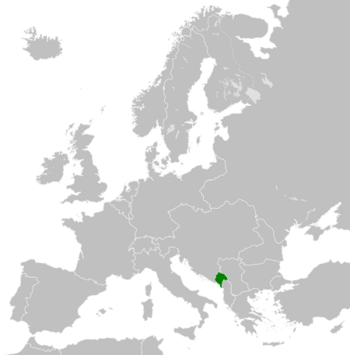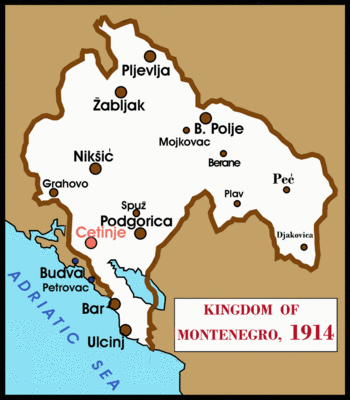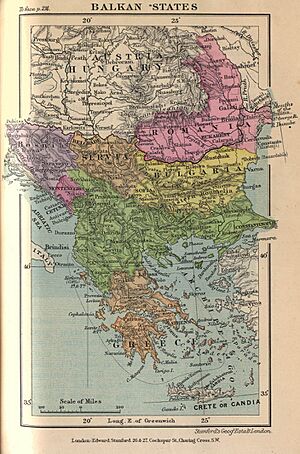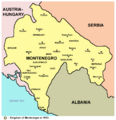Kingdom of Montenegro facts for kids
Quick facts for kids
Kingdom of Montenegro
Краљевина Црна Горa
Kraljevina Crna Gora |
|||||||||||
|---|---|---|---|---|---|---|---|---|---|---|---|
| 1910–1918 | |||||||||||
|
|
|||||||||||
|
Anthem: Убавој нам Црној Гори
Ubavoj nam Crnoj Gori ("To Our Beautiful Montenegro") |
|||||||||||

The Kingdom of Montenegro in 1914
|
|||||||||||

Kingdom of Montenegro in 1914 zoomed in the map with some cities
|
|||||||||||
| Capital | Cetinje | ||||||||||
| Capital-in-exile | Bordeaux Neuilly-sur-Seine |
||||||||||
| Common languages | Serbian | ||||||||||
| Religion | Serbian Orthodox (official) | ||||||||||
| Demonym(s) | Montenegrin | ||||||||||
| Government | Unitary parliamentary constitutional monarchy
|
||||||||||
| King | |||||||||||
|
• 1910–1918
|
Nicholas I | ||||||||||
| Prime Minister | |||||||||||
|
• 1910–1912 (first)
|
Lazar Tomanović | ||||||||||
|
• 1917–1918 (last)
|
Evgenije Popović | ||||||||||
| Legislature | Popular Assembly | ||||||||||
| Historical era |
|
||||||||||
|
• Proclamation
|
28 August 1910 | ||||||||||
| 1912–1913 | |||||||||||
| 30 May 1913 | |||||||||||
| 1914–1918 | |||||||||||
|
• Corfu Declaration
|
20 July 1917 | ||||||||||
|
• Podgorica Assembly
|
28 November 1918 | ||||||||||
| Area | |||||||||||
|
• Total
|
14.000 km2 (5.405 sq mi) | ||||||||||
| Currency | Montenegrin Perper | ||||||||||
|
|||||||||||
| Today part of | |||||||||||
The Kingdom of Montenegro (Serbian: Краљевина Црна Горa, romanized: Kraljevina Crna Gora) was a small country in southeastern Europe, where modern-day Montenegro is located. It existed for a short but important time, from 1910 to 1918, during a period of big changes in the Balkan Peninsula and World War I. Even though it was officially a constitutional monarchy (meaning the king's power was limited by a constitution), in reality, the king had a lot of power.
The Kingdom of Montenegro ended on November 28, 1918, shortly after World War I. At that time, the Montenegrin government was living in exile (outside the country). An important meeting called the Podgorica Assembly decided that Montenegro should join with the Kingdom of Serbia. Just three days later, on December 1, 1918, Serbia itself joined with other areas to form the Kingdom of Serbs, Croats and Slovenes. This union with Serbia lasted for nearly 88 years, until Montenegro became independent again in 2006.
Contents
A Look Back: The Kingdom of Montenegro

The Kingdom of Montenegro began on August 28, 1910. Before this, it was known as the Principality of Montenegro. Prince Nicholas of Montenegro was the ruler, and he decided to make his country a kingdom. He had been leading Montenegro since 1860.
King Nicholas I brought in many new ideas and changes in the early 1900s. For example, he introduced a constitution, which is a set of rules for how the country is governed. He also created a new type of money called the Montenegrin perper.
Montenegro and the Balkan Wars
Montenegro joined the First Balkan War in 1912. The goal was to gain more land from the Ottoman Empire, which was getting weaker. Montenegro did gain some new areas, sharing a region called Sandžak with Serbia in May 1913.
However, Montenegro had to give up a city called İşkodra (also known as Skadar, now Shkodër in Albania). The "Great Powers" (major European countries) insisted that this city should be part of the new country of Albania. This was because most people in Shkodër were ethnic Albanians.
When the Second Balkan War started in June 1913, Montenegro sided with Serbia. This war was mainly between Serbia and Bulgaria.
World War I and the End of the Kingdom
During World War I (1914–1918), Montenegro became an ally of the Triple Entente. This group included countries like France, Britain, and Russia. King Nicholas supported Serbia, which was also part of this alliance.
Because of this, Austria-Hungary attacked and took over Montenegro. The country was occupied from January 15, 1916, until October 1918.
In July 1917, an important agreement called the Corfu Declaration was signed. This agreement hinted that Montenegro and Serbia would eventually join together.
On November 26, 1918, a group of elected representatives called the Podgorica Assembly met. They decided that King Nicholas I, who was still living in exile, should no longer be king. They also voted for Montenegro to unite with Serbia.
At first, King Nicholas I had supported the idea of a larger state with Serbia, where his family would still be important. But after this decision, he changed his mind. He began to support Montenegrin nationalism and was against joining Serbia until he died in France in 1921.
On December 1, 1918, Serbia and Montenegro officially became a big part of the new Kingdom of Serbs, Croats and Slovenes, later known as Yugoslavia.
During World War II, some people thought about making Montenegro a puppet kingdom under Italian control. However, these plans never happened.
Leaders of the Kingdom
King of Montenegro (1910–1918)
- Nicholas I of Montenegro (1910–1918) - He was the only King of Montenegro.
Prime Ministers (1910–1916)
The Prime Minister was the head of the government. Here are some of the people who held this important role:
- Lazar Tomanović (1910–1912) - The first Prime Minister of the Kingdom.
- Mitar Martinović (1912–1913)
- Janko Vukotić (1913–1915)
- Milo Matanović (1915–1916)
- Lazar Mijušković (1916)
Prime Ministers in Exile (1916–1918)
After Montenegro was occupied in 1916, the government continued to work from outside the country. Here are the Prime Ministers during that time until the Kingdom ended:
- Lazar Mijušković (1916)
- Andrija Radović (1916–1917)
- Milo Matanović (1917)
- Evgenije Popović (1917–1918) - The last Prime Minister of the Kingdom of Montenegro.
Gallery
See also







